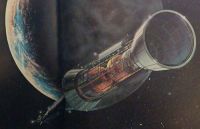Difference between revisions of "2040s (Columbia)"
From Trekipedia
(Created page with "<div align="center" style="width:99%;"> <div class="HeaderRow ButtonLeftCorners" style="display:inline;width:33%;">Prev: 2030s</div> <div class="HeaderRo...") |
m |
||
| Line 16: | Line 16: | ||
[[File:saratoga_class-sfc.jpg|200px|thumb|right|[[Saratoga class|''Saratoga'' class]] ([[Star Trek: Spaceflight Chronology (Book)|SFC]])]] | [[File:saratoga_class-sfc.jpg|200px|thumb|right|[[Saratoga class|''Saratoga'' class]] ([[Star Trek: Spaceflight Chronology (Book)|SFC]])]] | ||
* RSD 0/36: The [[Saratoga class|''Saratoga'' class]] cargo carrier enters service. With a crew of 18, ''Saratoga'' class vessels will remain in service until [[Chronology: 21st Century#2070|2070]].<ref name="SFC"/> | * RSD 0/36: The [[Saratoga class|''Saratoga'' class]] cargo carrier enters service. With a crew of 18, ''Saratoga'' class vessels will remain in service until [[Chronology: 21st Century#2070|2070]].<ref name="SFC"/> | ||
| − | * RSD 0/3605 | + | ===May=== |
| + | * RSD 0/3605: New space-time research from the [[Wells series probe|''Wells'' series probe]] [[U.N.P. Drake|U.N.P. ''Drake'']] find holes in the general theory of relativity, making faster-than-light communication and travel theoretically possible, though not yet a reality.<ref name="SFC"/><ref name="FASA2004A"/><ref name="FASA2214"/> | ||
==2048== | ==2048== | ||
| Line 35: | Line 36: | ||
<ref name="SFC">[[Goldstein, Stan]] and [[Goldstein, Fred]] with [[Sternbach, Rick]]. [[Star Trek: Spaceflight Chronology (Book)|Star Trek:'' Spaceflight Chronology'']]. [[Pocket Books]], 1980.</ref> | <ref name="SFC">[[Goldstein, Stan]] and [[Goldstein, Fred]] with [[Sternbach, Rick]]. [[Star Trek: Spaceflight Chronology (Book)|Star Trek:'' Spaceflight Chronology'']]. [[Pocket Books]], 1980.</ref> | ||
<ref name="FASA2004A">[[Wheeler, William John|Wheeler, Wm. John]] with [[McLimore, Guy W. Jr.]], [[Poehlein, Greg K.]], and [[Tepool, David F.]] "[[Cadet's Orientation Sourcebook (FASA-2004A)|Cadet's Orientation Sourcebook]]." ''[[Star Trek: The Role Playing Game (FASA)|Star Trek: The Role Playing Game]],'' Book 2004A. [[FASA Corporation]], 1983.</ref> | <ref name="FASA2004A">[[Wheeler, William John|Wheeler, Wm. John]] with [[McLimore, Guy W. Jr.]], [[Poehlein, Greg K.]], and [[Tepool, David F.]] "[[Cadet's Orientation Sourcebook (FASA-2004A)|Cadet's Orientation Sourcebook]]." ''[[Star Trek: The Role Playing Game (FASA)|Star Trek: The Role Playing Game]],'' Book 2004A. [[FASA Corporation]], 1983.</ref> | ||
| + | <ref name="FASA2214">[[McLimore, Guy W. Jr.]], and [[Poehlein, Greg K.]] "[[Star Trek III: The Search for Spock Sourcebook Update (FASA-2214)|''Star Trek III: The Search for Spock'' Sourcebook Update]]." ''[[Star Trek: The Role Playing Game (FASA)|Star Trek: The Role Playing Game]],'' Supplement 2214. [[FASA Corporation]]. 1984.</ref> | ||
</references> | </references> | ||
Revision as of 05:24, 7 May 2019
Reference Stardates 0/3200 - 0/4112
2040s
- The Galileo class is the primary ship class to the asteroid belt.[1]
2041
- RSD 0/33: The Companion class escort enters service. Carrying a crew of 20, Companion class vessels like the U.N.S.S. Fisher will remain in service until 2110.[1]
2044
- RSD 0/36: The Saratoga class cargo carrier enters service. With a crew of 18, Saratoga class vessels will remain in service until 2070.[1]
May
- RSD 0/3605: New space-time research from the Wells series probe U.N.P. Drake find holes in the general theory of relativity, making faster-than-light communication and travel theoretically possible, though not yet a reality.[1][2][3]
2048
- RSD 0/40: Commercial interplanetary travel begins with the inaugural flight of Solar Spacelines.[1]
- RSD 0/40: The Columbus class, boasting an advanced fusion drive, enters service as Earth's largest space-going vessels. With a crew of 40, the U.N.S.S. Icarus is one of the more notable ships of the class.[1]
- RSD 0/40: The Magellan class space liner, with a capacity of 260 passengers and an advanced fission drive, enters service. The U.N.S.S. Prince of Wales, launched this year and commanded by Captain Lars Olmstead, is a notable example of the class, and remains in service for more than three decades.[1]
References
- ↑ 1.0 1.1 1.2 1.3 1.4 1.5 1.6 Goldstein, Stan and Goldstein, Fred with Sternbach, Rick. Star Trek: Spaceflight Chronology. Pocket Books, 1980.
- ↑ Wheeler, Wm. John with McLimore, Guy W. Jr., Poehlein, Greg K., and Tepool, David F. "Cadet's Orientation Sourcebook." Star Trek: The Role Playing Game, Book 2004A. FASA Corporation, 1983.
- ↑ McLimore, Guy W. Jr., and Poehlein, Greg K. "Star Trek III: The Search for Spock Sourcebook Update." Star Trek: The Role Playing Game, Supplement 2214. FASA Corporation. 1984.

